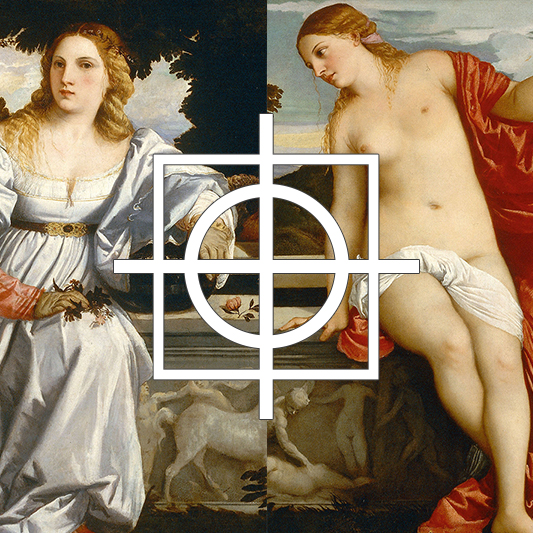真正的愛情就是靈魂擁抱肉體···
本文最初發表於我和妻子的微信公眾號: 人面魚Fisage, 有增改。
一、聖潔瑪麗亞
每個男人心中都有兩個女神: 天上的瑪麗亞與地上的維納斯。
在男人的少年時代,他嚮往純潔、天真、善良與一切光明美好之所在,他渴望一個和他一樣,願意和自己分享生命中所有快樂和悲傷,一同交流並理解整個人生的意義,一起邂逅命運的奇蹟和偉力,共同前行並陪伴成長的伴侶。這個最美麗而純潔的女性形象,從他的生命伊始就深深鏽刻於他心底之處,在每個命運的暗夜裏猶如耀目卻遼遠的星辰照耀著於他頭頂,指引他前往正確的方向。男人依據他們久遠純真年代的理想創造了瑪麗亞–聖潔、美好、飄渺、凜然不可侵犯,可遠觀而不可褻玩焉。這個形象同時滿足了男人兩個奇異而自相矛盾的理念: 一方面無比嚮往卻始終不可得,另一方面卻又滿足了他某種具有偶像崇拜的理想–畢竟,從人類古老的紀元開始,男人們就都依據著身邊女性的形象創造出可資崇拜的女神,一個可以在心底裏悄悄愛慕思念,同時又高高在上、不可褻瀆之神祗。瑪麗亞無性受孕的奇蹟在古代不同民族和不同文明的神話裏都有相似的描述–可能,一個永遠無法被徹底完全佔有的女人,一個虛幻又完美的女人,一個永遠可望而不可及的女人,才是一個扎根埋藏於男人心底最深處執著又纖柔的斑斕之夢。或許,這是男人幼年時代被母親們祐護回憶的影子,或許,這是人類早期母系社會殘留在男人血液和基因中的先祖血脈記憶,她就是一個正永遠被不斷創立、建造並補全的聖殿,一個被每一代男人內心願望和期許不斷折射並投影的對象–一切對女性的所有美好純潔嚮往的起點,就是男人心中完美無暇瑪麗亞之發端。

約翰‧科利埃《湯豪瑟在維納斯堡》
二、艷絕維納斯
然而,女神仙子雖美麗純潔,卻也虛無飄渺,隨著男人涉世漸深,他們會慢慢開始懂得欣賞另外一種女性: 地上的維納斯–性感、放蕩、媚惑、妖嬈、活色生香、直呈出人心深處最赤裸而真實的慾望。沒有什麼比在辛勞一天之後,在溫暖如春的花床上觸摸一具熾熱滾燙、嬌嫩光滑就似芬芳綻放之花苞,活力四溢猶如藤蔓般溫柔纏繞的女體更令人感到幸福了: 白晝所有的奔波和疲倦在母性般最大的包容裏得到了全部的撫慰和釋放,就好像是所有努力終於換來的獎賞一般。男人學會了坦誠地面對自己真實的慾望和需求,不再僅僅把女性視為居於高高雲端的女仙,她同時也是個有血有肉、可以被擁抱、愛撫和佔有的女人: 在這裡,聖母與天使步下了神壇,化身芸芸眾生中一介凡女,和現世的男子結為伴侶,共度春秋。就如同在基督教統治大地的時代,從奧林匹斯山(Olympia, [1])上被永遠放逐的女神維納斯也化身為美豔絕倫的女子,到凡間招攬誘惑種種優秀的男人到她的維納斯堡(Venusberg, Mont de Vénus, [2]),在夜夜笙歌的迷醉中化解失去往昔榮耀和快樂的痛苦。從那時候開始,無數的男人就沈醉在維納斯的溫柔鄉中不可自拔,直到行吟歌手湯豪瑟(Tannhäuser, Tanhûser, [3])迷途知返,救贖才成為可能。
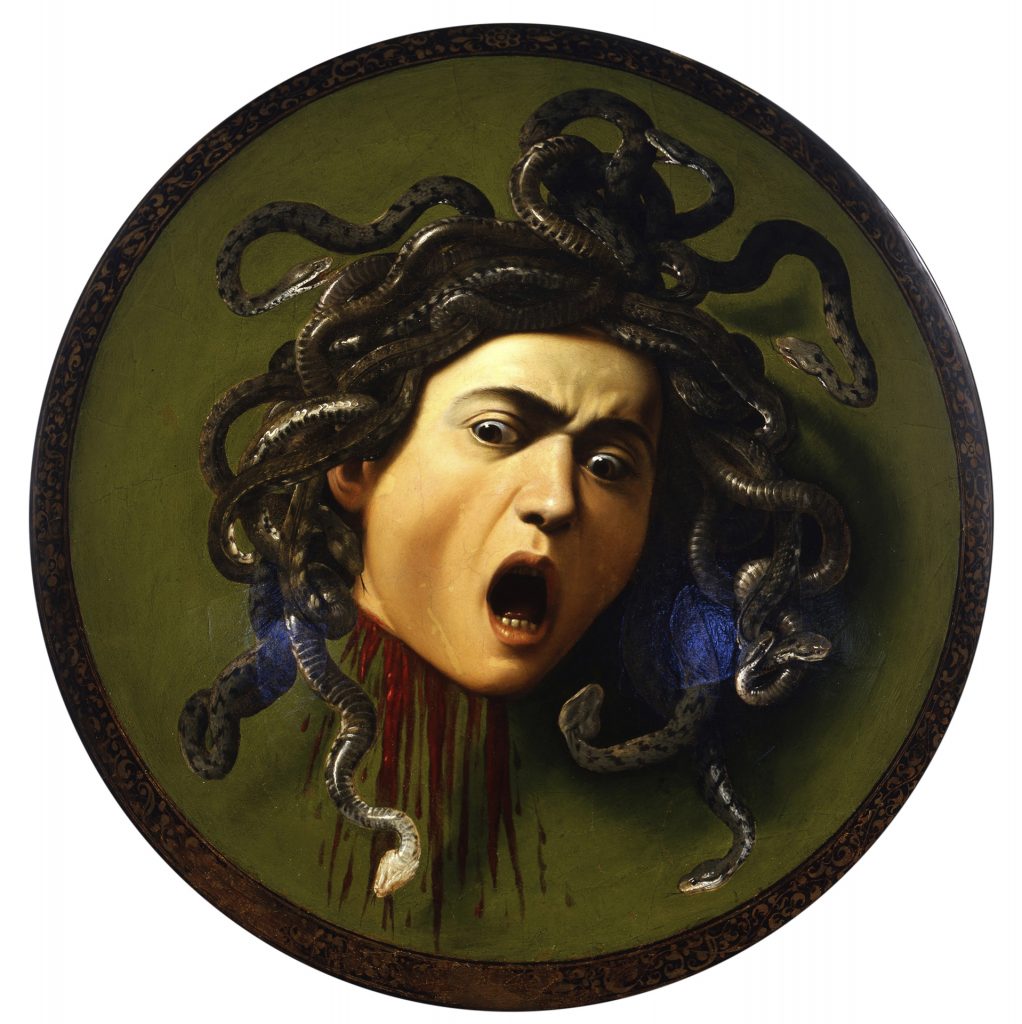
卡拉瓦喬《美杜莎首級》
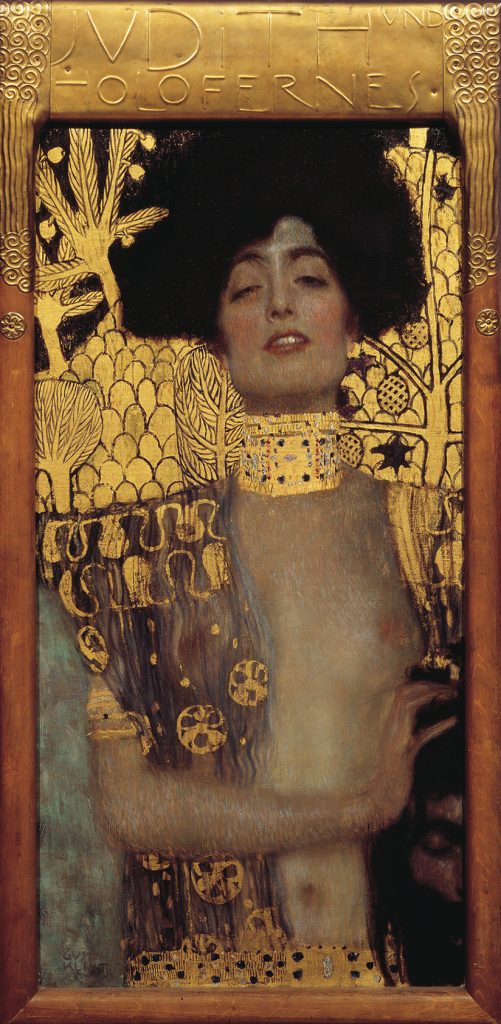
古斯塔夫‧克里姆特《茱蒂絲與赫羅弗尼斯》
三、致命美杜莎
在迷戀沈浸於女性溫柔鄉的同時,男人又往往畏懼於被女性魅力擺佈主宰之危險,無論是令人瞬間石化的蛇髮女妖美杜莎(Medusa, Μέδουσα, [4]),還是斬下敵軍將領赫羅弗尼斯(Ὀλοφέρνης, הולופרנס, Holofernes, [5])首級的茱蒂絲(יְהוּדִית, Judith, [5]), 抑或是畸戀虐殺施洗者約翰(יוחנן המטביל, John the Baptist, [6])的公主莎樂美(Σαλώμη, שלומית, Salome, [7]), 無一不是性感、狠毒、致命如同罌粟花般的蛇蠍美人(femme fatale, [8])之象徵。兩性關係間的相互吸引和相互憎恨,相互慰籍和相互利用,這種錯綜複雜的關係猶如懸掛於男人頭頂的達摩克利斯之劍(Sword of Damocles, Δαμοκλῆς, [9]), 縱是千般萬般危險,卻仍使男人們食髓知味,欲罷不能。
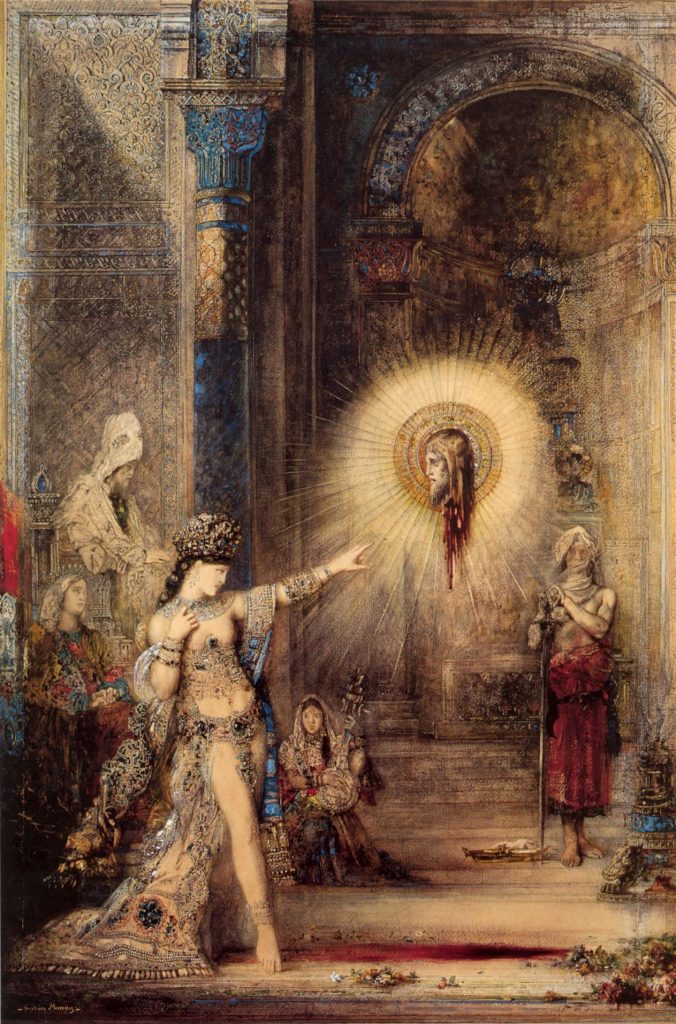
古斯塔夫‧莫羅《莎樂美, 幻影》
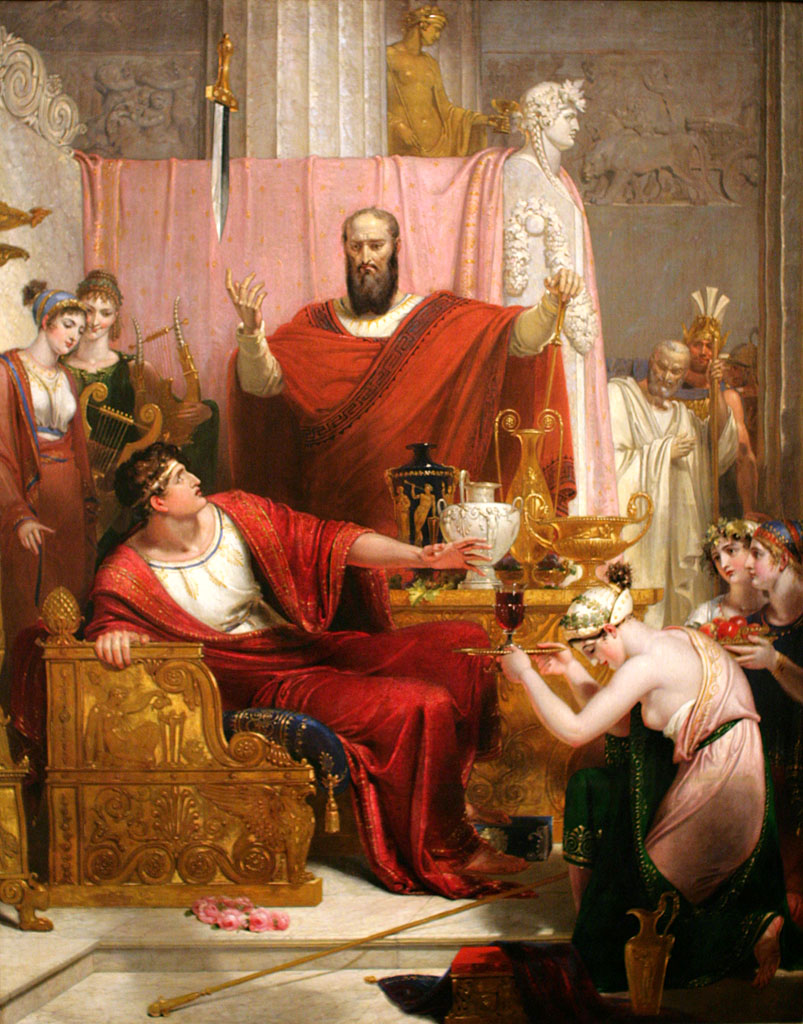
理查德‧韋斯托爾《達摩克利斯之劍》
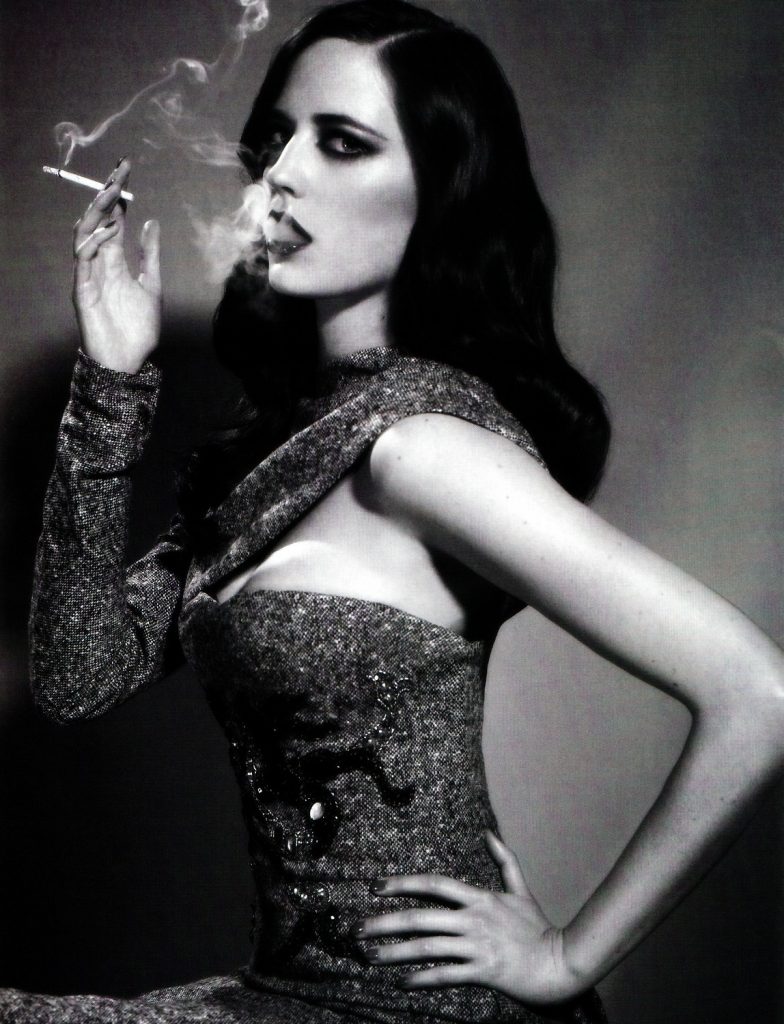
蛇蠍美人
男人一邊享受著維納斯的美妙肉體和柔情溫暖,另一邊則還在靈魂深處嚮往著曾經美好的聖母: 湯豪瑟始終無法擺脫靈魂深處的詰問和譴責,痛苦的他出發朝聖尋找聖母的救贖。可是假若讓男人拋棄已經到手的快樂,為了心中曾經純潔的理想和追求,再去追尋那可望不可及的天上之愛,那也是萬萬不能的事情。所以,如同那隻在兩垛等距草料間來回猶豫糾結的騾子,男人陷入這個困境長達千年: 一邊是超凡的愛–神聖、節制、自律、純潔、引導靈魂不斷昇華,絢爛得猶如暴雨後斑斕的彩虹; 另一邊則是地上的愛–鮮活、放蕩、淫靡、令人沈淪無邊慾海,燈紅酒綠就似午夜的狂歡。人性如同永動的鐘擺,在左右的晃動和搖擺中忍受著撕裂的掙扎和分離的痛苦。

薩爾瓦多‧達利, 菲利浦‧哈爾斯曼《旖麗之死》
四、愛之本質
或者說,男人的困頓也好,女人的兩面也好,男人和女人的關係,其實不過是他(她)們自身與外部世界關係的映射與投影: 建立一段持久、成熟而健康的兩性關係,其實就是一條自我實現的參道(sandō, さんどう, [10]),是一種個人自我內在審美和價值觀之外化體現。一個男人或女人的內心世界,可以通過他(她)選擇的伴侶窺見一斑–因為伴侶,乃是個人生命的另一種形式和價值之化身,乃是一體兩面的雅努斯(Iānus, Janus, [11]), 即是命運之路分岔的起始,也是結尾。我們通過伴侶補全了生命中與生俱來的缺失,他(她)是我們生命拼圖的另一半,也是未來前行道路的方向與座標。通過與另一半的結合,我們生命的形式發生了根本的改變並帶來了另外之新興可能。在健康的男女關係中,男人和女人的生命力通過性與愛得到了最大程度的釋放和昇華,猶如潺潺流水,都是無數萬千水世界的循環與縮影,不管是給予或者索求,都應被視為是同等重要的道德,並得到相同的尊重和滿足。
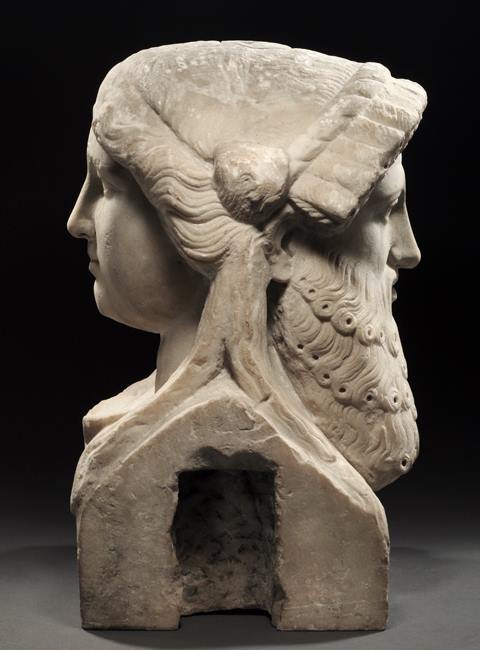
雅努斯雕像
五、靈魂擁抱肉體
抑或者,天上的愛和地上的愛,不過是物質與精神,靈魂和肉體間雙重關係之象徵,是從一出世就受二元論(Dualismus, [12])困擾的人類難解的謎題。男女間如果沒有精神上的相互理解,相互溝通,沒有靈魂上的共鳴與心靈的契合,就沒有愛情的誕生;但是,假若缺乏靈魂和心靈寓居其間的肉體,沒有兩性軀體間相互吸引的力比多(libido, [13]), 也就不會有男女之愛的發軔,所以,真正的“愛情就是靈魂擁抱肉體(L’amour, c’est l’ésprit qui s’embrasse le corps.)”。其實,在愛情中,靈魂和肉體本不應該是非此即彼之所在,正是愛情,使得我們的靈魂和肉體更為緊密地結合在一起,永不分離。希臘神話中二首四手四足的造物在被眾神之王宙斯分成兩個相同的部分並放逐到相距最遙遠的地點後,這兩個部分就開始終生不止息地尋找對方並最終重新結為一體–在愛情中,也許他人看到的是兩個人,其實,他們是一個人,一個終於完的“人”。男人們飽受困擾和折磨的命題,不過就是一個上帝可以捧腹的笑話: 靈肉一致才是愛情本來的面目。
2017 Sep. 09 ~ 2020 May 02
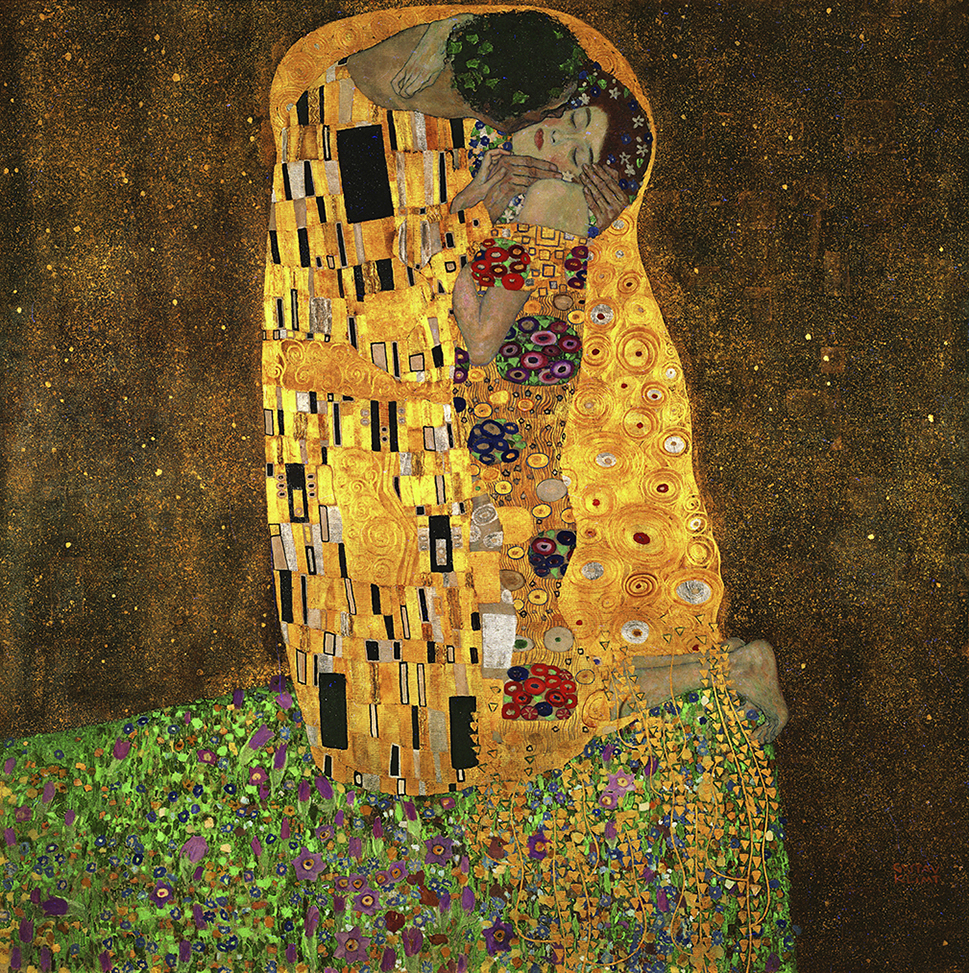
古斯塔夫‧克里姆特《吻》
註釋:
[1]. 奧林匹斯山(Olympia, Όλυμπος), 希臘神話傳說中眾神、半神及其僕從居住的所在。
[2]. 維納斯堡(Venusberg, Mont de Vénus), 歐洲中世紀晚期的傳奇民謠主題,傳說中維納斯女神離開奧林匹斯山後居住之所,她常常誘惑年輕英俊的男青年來尋歡作樂,湯豪瑟是最為著名的例子。
[3]. 湯豪瑟(Tannhäuser, Tanhûser), 中世紀日耳曼著名行吟詩人和歌者(Minnesinger)。
[4]. 美杜莎(Medusa, Μέδουσα), 希臘神話中的蛇髮女妖,任何直視她的人都會變成石頭。
[5]. 茱蒂絲(יְהוּדִית, Judith), 聖經舊約中的人物,猶太寡婦,用美色誘惑亞述軍將領赫羅弗尼斯(Ὀλοφέρνης, הולופרנס, Holofernes)並斬下其首級,解救耶路撒冷。
[6]. 施洗者約翰(יוחנן המטביל, John the Baptist), 據基督教,施洗者約翰在約旦河中為人施洗禮、勸人悔改,後他因公開抨擊猶太王希律·安提帕斯被捕入獄並遭處決。
[7]. 莎樂美(Σαλώμη, שלומית, Salome), 聖經人物,小亞美尼亞公主,在王爾德的戲劇中愛上了施洗者約翰,並要求父王砍下他的頭。
[8]. 蛇蠍美人(femme fatale), 指用自身的美色、魅力、床技等誘惑男人沉溺的女性,而為之傾倒的人多數下場悲戚,如失去地位、家庭、政權甚至是自己的性命。法語原意指“致命女人”。
[9]. 達摩克利斯之劍(Sword of Damocles, Δαμοκλῆς), 意指永遠懸於當權者頭頂上的致命危險。
[10]. 參道(sandō, さんどう), 指信眾到廟宇、寺院、陵園等祭祀場所參拜的道路。
[11]. 雅努斯(Iānus, Janus), 羅馬神話中的雙面門神,象徵開始與結束。
[12]. 二元論(Dualismus), 該理論認為,世界由兩種不可缺少且相互獨立並相互作用的元素組成,由此推廣到其它領域。
[13]. 力比多(libido), 該術語由德國精神分析學家西格蒙德·佛洛伊德(Sigmund Freud)提出,指身體內部的興奮狀態的本能,其欲念、動機的來源或基本力量。
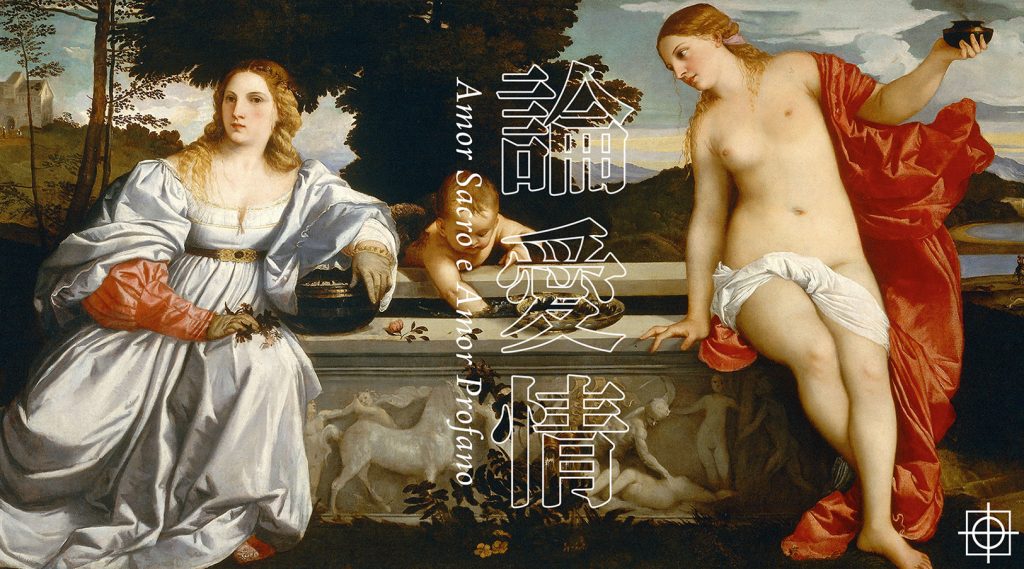
提香《天上的愛和人間的愛》
EN
L’amour, c’est l’ésprit qui s’embrasse le corps.
This article was first published on WeChat official account: 人面魚Fisage, co-authored by me and my wife, it has been revised since then.
I. Celestial Maria
There are two goddesses in heart of every man: Maria in the heaven and the Venus on the earth.
In man’s boyhood, he yearned for all the pure, naïve, good, bright and wonderful beings in the world, he was eager to have a girl like himself to share all the happiness and sorrow in his life, to commune and understand the meaning of the whole life with each other, to encounter the miracles and grandness of the destiny, a mate to travel along and to grow up with him. And this most beautiful and purest figure of woman has been carving and sculpturing into the deepest bottom of his heart, shining like a splendid yet far away star in the dark night of destiny above his shoulders, guiding him to the right direction. According to the ideology from the old and naïve days from their early lives, the men have created the image of Maria— celestial, wonderful, ethereal, never-be-blasphemed, which can only be seen and worshiped from a long distance. This figure has been satisfying two bizarre and totally contrary ideologies of man simultaneously: an idol that he is yearning for and loving with passion but can never be touched on one hand, yet satisfying his wish of worship somehow on the other hand— after all, from the very ancient epoch of human race, the man had been creating goddesses in the altar for worship based on the images of the females around him in the daily life, a deity that he can love and miss in his heart secretly while still hold her position high above in the sky with no possibilities of blasphemy. The miracle of Miria’s pregnancy without sex has some similar descriptions in different human races, mythologies and civilizations— perhaps, a woman that can never be conquered or possessed entirely, a perfect woman like a phantom, an impeccable woman that can only be viewed but can never be touched, is a most persistent, soft, delicate, slender and gorgeous dream deeply rooted in the profoundest heart of man. Or maybe she is a shadow casted by the mémoire of man’s mother from his childhood, maybe, she is the last remnants of the memory in the bloodline or genes of man from the very beginning of the matrilineal era. She is a temple that has been creating, building and perfecting forever, an object that has been reflecting and casting the inner wishes and expectations of men— a start point of the yearning for all the wonders and goodness of woman, indeed, an origin of the perfect Maria in man’s heart.
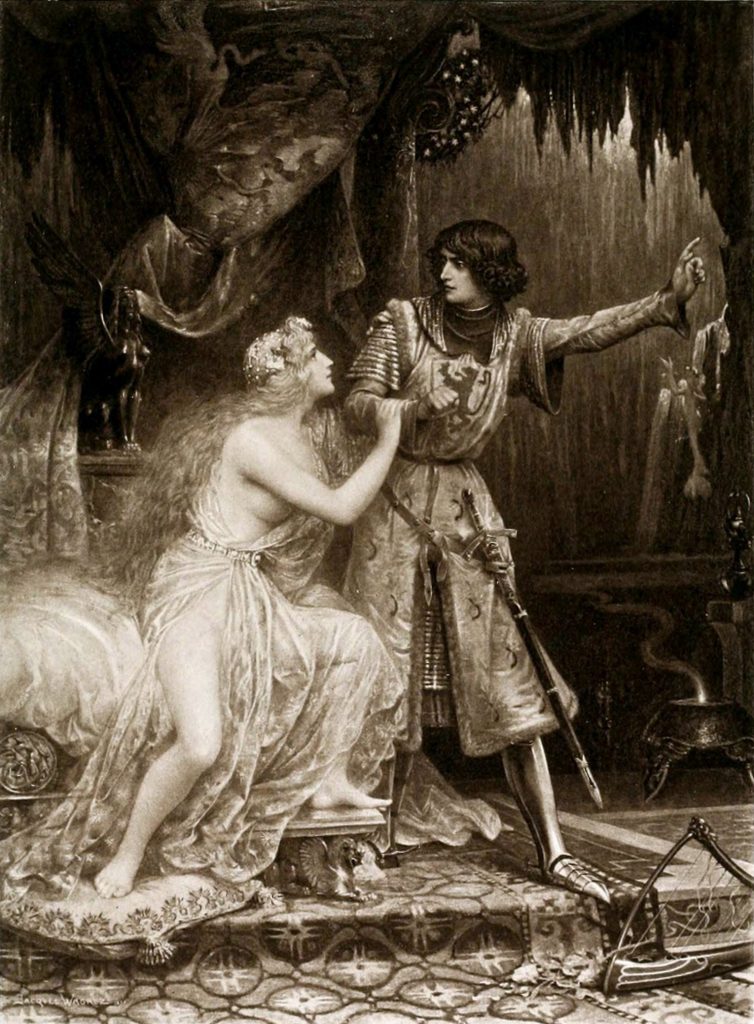
雅克·克萊蒙·瓦格雷《湯豪瑟在維納斯堡》
II. Voluptuous Venus
Though beautiful and pure, the goddess and fairy with auras are ethereal and immaterial, as the men slowly stepping into the ocean of the mundane world, they started to know how to appreciate another kind of woman: Venus on the earth— sexy, debauchery, charming, glamorous, vivid with fresh flesh, presenting the most naked, truest desires and lusts in the heart of man directly. Nothing can be compared with the happiness of touching a female body hot as lava, soft, delicate, smooth as a blooming, fragrant petal of a bud, vigorous and energetic as a gently intertwining vine on the warm bed of abundant flowers in spring: all the fatigue and tiredness of the daytime could be totally comforted, released and erased in the whole tenderness and tolerance of the maternity, just like a reward granted and bestowed after all the efforts at last. The man has learned to face his real desires and lusts frankly and plainly, they are now not only regarding woman as a goddess above the clouds, but also someone with vivid, fresh blood and fleshes, who could be embraced, caressed and possessed finally: in this scenario, Notre Dame has stepped down from the altar, transforming herself into a common woman among us, marrying an ordinary man on the earth and spending the rest of her life with him together. As the era after the Christianity has conquered and ruled all the lands, Goddess Venus banished eternally from Olympia [1] has transformed herself into a beautiful and charming woman, attracting and luring all kinds of excellent and unique men from all over the world to her Venusberg [2], immersing and intoxicating herself with them every nights to forget and cure the pain of the lost bygone glory and happiness. From that day forward, innumerable men have been helplessly falling and sinking into the net and trap of Venus’ tenderness forever. The salvation is not possible until the Minnesinger (troubadour) Tannhäuser’s(Tanhûser, [3]) self-awareness.
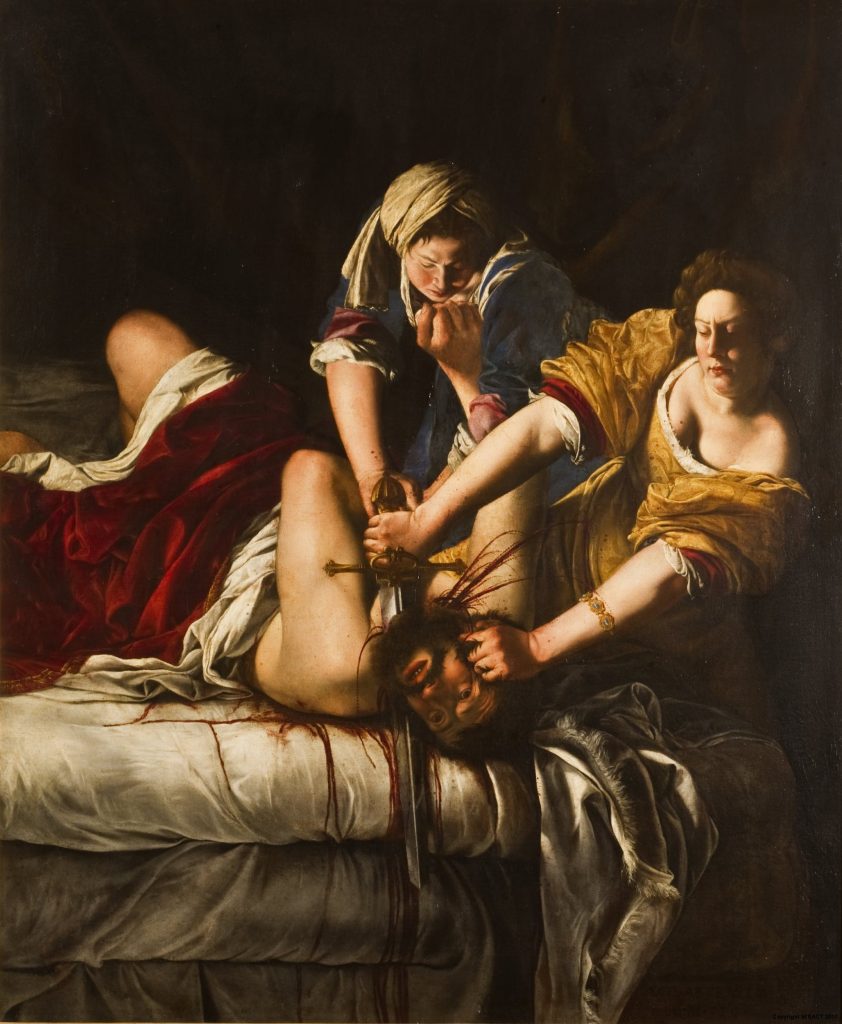
阿特蜜希雅·真蒂萊希《茱蒂絲割下赫羅弗尼斯之頭顱》
III. Deadly Medusa
In the meantime of intoxicating with the beauty of woman and immersing into the tenderness of her, the man is fearing the danger of being controlled and dominated by the charms of woman. No matter the frightening and dreadful Gorgon Medusa(Μέδουσα, [4]) turning the viewers gazing upon her face into stones, or Judith(יְהוּדִית, Yehudit, [5]) beheading the general Holofernes(הולופרנס, Ὀλοφέρνης, [5]), the foe of Bethulia(בתוליה, Βαιτυλούᾳ), or even the Princess Salome(שלומית, Σαλώμη, [6]) torturing and killing John the Baptist(יוחנן המטביל, Ιωάννης ο Βαπτιστής, [7]), all in all, are the symbols of the sexy, vicious, ruthless and deadly “femme fatale [8]” as the flower of poppy. The attraction and hatred between both parties, contributing comforts while taking advantages of each other, this complicated and difficult relationship is like the Sword of Damocles (Δαμοκλῆς, [9]), though on the brink of perish and destruction, man are still fond of it and hooked forever.
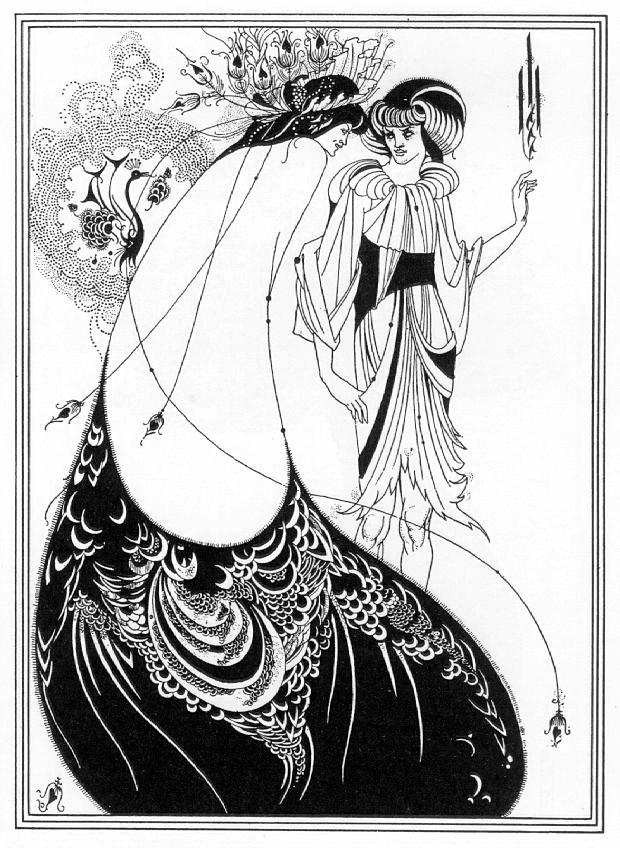
奧伯利‧比亞茲萊《莎樂美, 孔雀裙》
When man appreciating and tasting the wonderful body, tenderness and warmth of Venus, he is still yearning for the once celestial Notre Dame in the soul: Tannhäuser can not tolerate and resist the interrogations and condemns in his heart and soul, the pain and agony urged him to seek for salvation in the pilgrimage. But it would be impossible if someone asks the man to abandon the happiness that he’s already earned and to look for the celestial, ethereal love in the heaven for the sake of once pure dream and pursuit. In another word, like a mule hesitating and confusing between the two exact same piles of forage with exact same distances, man has been caught in the mire of dilemma for thousands of years: on one side is the love in the heaven: holy, celestial, moderate, self-disciplined, pure, guiding the soul onto a higher level, splendid and subtle like the gorgeous rainbow after thunderstorms; on the other side is the love on the earth: vivid, debauchery, obscene, luring them into the immense oceans of lusts, crazy and drunken as a wild carnival at midnight. The humanity is like a perpetual pendulum, which is suffering from the pain and agony in struggles of tearing and separating, with the movement of swinging and shaking.
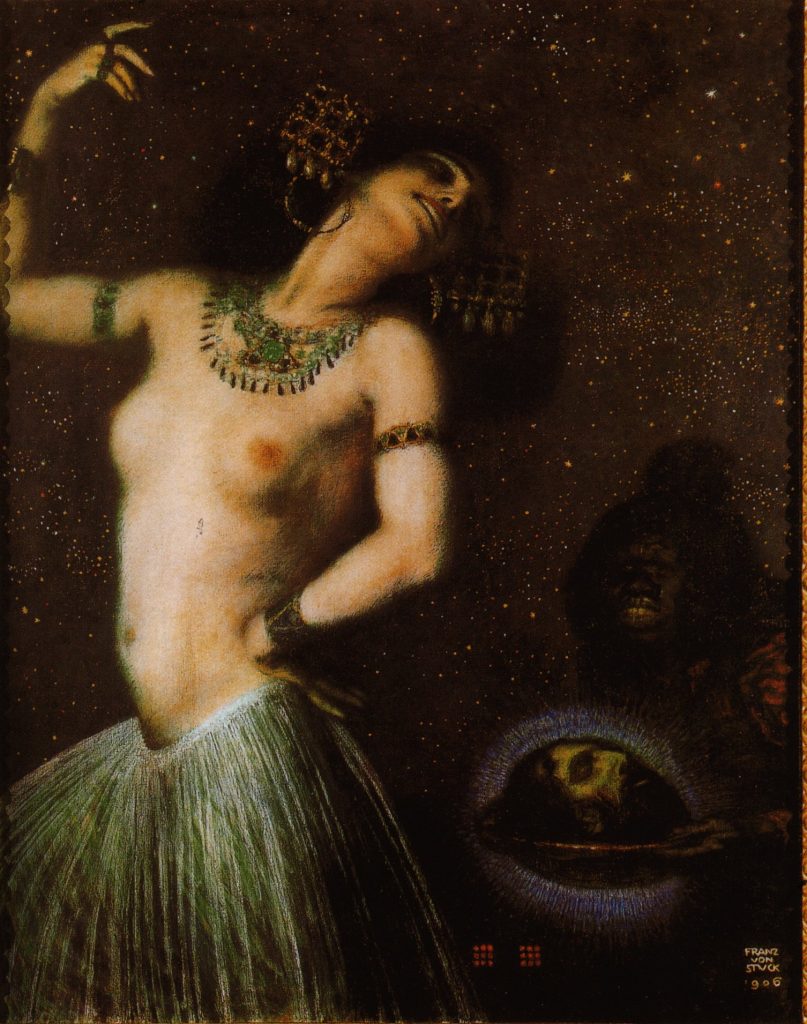
弗蘭茨‧馮‧斯圖克《莎樂美》
IV. Quintessence of Love
In other words, no matter be that the confusion of man or the dual natures of woman, the relationship between both is simply a reflection and cast of their inner selves with the exteriors world: building and constructing a long-lasting, mature and healthy relationship between both is a sandō(参道, さんどう, visiting path, [10]) for the pilgrimage of self-realization, an appearance of inner self-æsthetics and self-values. We can simply catch a glimpse of man/woman’s inner world through his/her chosen mate— because the mate is just another incarnation of person’s possible form and value, a Iānus(Janus, [11]) with two visages in one body, both the beginning and the end at the crossroad of fate. By our mates, we have fulfilled the incompleteness of our lives, he/she is just the very half of jigsaw puzzle or map in our lives, the coordinate and direction of our coming future. Bound with each other, our life forms will certainly be changed fundamentally and gain other new possibilities. In a healthy relationship between man and woman, the power and vitality of both will be released, blessed, sublimed and recycled through love and sex. Just as the flowing streams of water, which is the circulation and miniature of the countless worlds of water. Be that giving or asking, they all should be regarded as proper morality with same importance, earning their esteems and satisfactions respectively.
V. Soul Embracing Body
Or else, the love in the heaven or on the earth, are just standing for the double relationships between material and spirit, body and soul, an enigma can never be settled by our human being born with the confusing dilemma of Dualismus [12]. Without the understanding and communicating of man and woman in the spirit, without the matching of the hearts or the resonance of the souls, there will be no love; yet without the body for the souls and hearts to lingering around and living in, there will surely be no libido [13] attracting bodies of both genders, and so will never be birth of love between man and woman. And that’s why: “L’amour, c’est l’esprit qui s’embrasse le corps (True love is the soul embracing the body)”. Actually, we should never choose one but discard the other. It is love that combines our bodies and souls together eternally. In ancient Greek mythology, after the creature with two heads, four arms and four legs were divided into to two equal parts by the King of Gods, Zeus, and placed into the two most far-away places in the world, these two counterparts had been tirelessly seeking each other for uniting together again in their whole life from that moment on— other people may regard the couple as two independent persons, yet in fact, they are just one human, a complete “humana” with no missing parts finally. The proposition confusing and torturing the man is just a joke that God may burst out with belly laughs: the true visage of love is the body and soul fused in harmony together.
2017 Sep. 09 ~ 2020 May 02
NOTES:
[1]. Olympia(Όλυμπος), the mountain where all the Greek gods living upon.
[2]. Venusberg(Mont de Vénus), a motif of European folklore since the Late Middle Ages, a place where “a mortal man seduced by the fairy queen visits the otherworld”.
[3]. Tannhäuser(Tanhûser), a famous German Minnesinger and poet in the Middle Age.
[4]. Gorgon Medusa(Μέδουσα), in ancient Greek mythology, she was a monster with human female head and living venomous snakes in place of hair, anyone gazing upon her face will turn to stones.
[5]. Judith(Yehudit, יְהוּדִית), a beautiful Jewish widow, who had lured the enemy General Holofernes(Ὀλοφέρνης, הולופרנס) and beheaded him, saving Jerusalem.
[6]. Salome(Σαλώμη, שלומית), figure from Bible, in Oscar Wild’s thrilling play, she had fallen in love with John the Baptist and asked the king to give her the head of John.
[7]. John the Baptist(יוחנן המטביל, Ιωάννης ο Βαπτιστής), was a Jewish itinerant preacher in the early 1st century AD.
[8]. Femme fatale, a stock character of a mysterious, beautiful, and seductive woman whose charms ensnare her lovers, often leading them into compromising, deadly traps.
[9]. Sword of Damocles(Δαμοκλῆς), an allusion to the imminent and ever-present peril faced by those in positions of power.
[10]. Sandō(参道, さんどう, visiting path), in Japanese architecture is the road approaching either a Shinto shrine or a Buddhist temple.
[11]. Iānus (Janus), in ancient Roman Mythology, with two faces, he was the god of Gate, beginnings and endings.
[12]. Dualismus (Dualism), the belief that reality is fundamentally composed of two parts.
[13]. Libido(sex drive), a person’s overall sexual drive or desire for sexual activity.
聲明: 本篇音樂來自義大利作曲家塔爾奎尼奧·梅魯拉(Tarquinio Merula)的《愛之里拉(Su La Cetra Amorosa)》第一首“愛之里拉(Su La Cetra Amorosa)”, 演唱者: 蒙瑟拉特·菲格拉斯(Montserrat Figueras), 演奏: 約爾迪·瑟拜爾(Jordi Savall)等, AVSA 9862, Alia Vox(2008), 所有繪畫和雕塑作品圖片來自國際網路, 其它文字、翻譯及圖片均為原創,請勿用於商業用途,謝謝!
